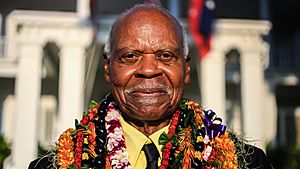Ernest J. Harris facts for kids
Quick facts for kids
Ernest James Harris
|
|
|---|---|

Harris smiles after receiving the Congressional Gold Medal in 2016 for his service as a Montford Point Marine
|
|
| Born | May 24, 1928 |
| Died | February 20, 2018 (aged 89) |
| Alma mater | University of Hawaii University of Arkansas at Pine Bluff |
| Scientific career | |
| Institutions | United States Department of Agriculture University of Arkansas at Pine Bluff University of Minnesota |
| Thesis | Biotic factors influencing population trends of the Mediterranean fruit fly, Ceratitis capitata (Wiedemann), in selected host habitats in Tunisia (1975) |
Ernest James Harris (born May 24, 1928 – died February 20, 2018) was an American scientist. He studied insects, so he was an entomologist. He is famous for his work with a special kind of wasp called Biosteres arisanus. In 1999, he was honored by being added to the Arkansas Black Hall of Fame.
Contents
Early Life and Education
Ernest Harris was born in North Little Rock, Arkansas. He was the youngest of six children. His family lived on a 45-acre cotton farm. They did not have electricity. Every year, Ernest missed school to help pick cotton during harvest time. He had to study by candlelight. Even as a child, he was very interested in insects.
Ernest went to Pulaski County Training School. This school was segregated at the time. After graduating, he wanted to become an airplane mechanic. He joined the United States Marine Corps. He was one of the first African-Americans to serve in the Marines. He was a Montford Point Marine, which meant he trained at a segregated camp.
After his military service, a new program called the G.I. Bill helped Ernest go to college. He attended the University of Arkansas at Pine Bluff. There, he focused on chemistry and zoology. After college, he struggled to find a job in his field. He eventually found work in Milwaukee, studying the chemical makeup of ores.
Research and Career
Later, Ernest Harris moved to Minnesota. He joined the United States Forest Service. While working there, he also studied entomology at the University of Minnesota. He researched weevils, which are a type of beetle. He then returned to the University of Arkansas at Pine Bluff. There, he became a science lecturer.
In 1962, Harris moved to Hawaii. He was asked to join the United States Department of Agriculture (USDA). He became one of the first African-American research scientists at the USDA. He worked there for almost 40 years. He led a team that studied biology and ecology.
While in Hawaii, Harris started a doctoral program. He studied how populations of the Mediterranean fruit fly (Ceratitis capitata) changed over time. He spent a lot of time researching Biosteres arisanus. This is a type of wasp that lays its eggs inside fruit fly eggs.
The "Harris Strain" Wasp
Several countries used the "Harris strain" of this wasp to get rid of fruit flies. For example, Chile has been free of fruit flies since 1975 because of this work. This success earned Harris a special award from the government of Chile. His research also helped California create its program to control Mediterranean fruit flies. Harris also found ways to raise Fopius arisanus. This is another parasite that attacks Mediterranean fruit flies and melon flies.
Ernest Harris retired in 2006. However, he continued to work for the USDA in Honolulu until the office closed in 2009.
Awards and Honors
Ernest Harris received many awards for his important work:
- 1989: He was inducted into the Royal Entomological Society.
- 2012: He received the NAACP Lifetime Achievement Award for Distinguished Service.
- 2016: He was awarded the Congressional Gold Medal.
Personal Life
Ernest Harris was married to Bettye Jo Harris. They met in Milwaukee. Together, they had three children.

